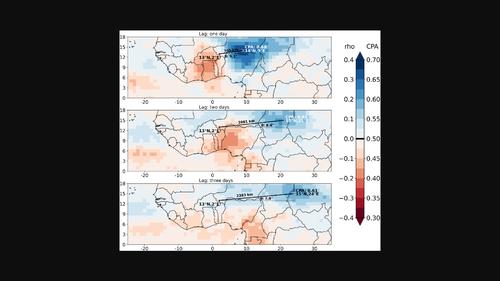西非夏季风天气尺度降雨的可预测性来源
IF 3
3区 地球科学
Q2 METEOROLOGY & ATMOSPHERIC SCIENCES
引用次数: 0
摘要
与基于气候学的预报和其他热带地区相比,基于数值模式的降水预报在热带北部非洲表现出较差的技巧。然而,正如最近所证明的那样,基于网格化卫星降雨估算推断出的时空相关性的纯数据驱动预测显示出对该地区24小时降水发生率的预测前景。目前的工作通过推进统计模型和提供性能结果的气象解释进一步探索了这一潜力。进展包括(a)使用最近开发的相关度量,预测能力系数(CPA)来识别预测因子,(b)使用稳健的可靠性图和分数分解进行预测评估,(c)热带非洲的研究域嵌套在相当大的时空域中以识别相干传播特征,以及(d)引入新的相干-线性-传播因子来量化传播信号的相干性。统计预报与基于气候学的基准、欧洲中期天气预报中心(ECMWF)的业务集合预报和统计后处理的集合预报进行比较。在热带非洲北部的主要雨带内,所有方法都显示出较差的技巧,在那里,不同方法之间Brier分数的差异几乎没有统计学意义。然而,在经向降雨梯度较大的雨带边缘,数据驱动的预报优于其他方法。相干-线性-传播因子,与对流有效势能和对流不稳定性的度量相一致,揭示了雨带的高随机性限制了可预测性。在雨带边缘,数据驱动方法利用了与传播热带天气系统(如非洲东风波)相关的相干降水特征。本文章由计算机程序翻译,如有差异,请以英文原文为准。

Sources of predictability of synoptic‐scale rainfall during the West African summer monsoon
Abstract Numerical‐model‐based forecasts of precipitation exhibit poor skill over northern tropical Africa when compared with climatology‐based forecasts and with other tropical regions. However, as recently demonstrated, purely data‐driven forecasts based on spatio‐temporal dependences inferred from gridded satellite rainfall estimates show promise for the prediction of the 24‐hr precipitation occurrence rate in this region. The present work explores this potential further by advancing the statistical model and providing meteorological interpretations of the performance results. Advances include (a) the use of a recently developed correlation metric, the Coefficient of Predictive Ability (CPA), to identify predictors, (b) forecast evaluation with robust reliability diagrams and score decompositions, (c) a study domain over tropical Africa nested in a considerably enlarged spatio‐temporal domain to identify coherent propagating features, and (d) the introduction of a novel coherent‐linear‐propagation factor to quantify the coherence of propagating signals. The statistical forecast is compared with a climatology‐based benchmark, the European Centre for Medium‐Range Weather Forecasts (ECMWF) operational ensemble forecast, and a statistically postprocessed ensemble forecast. All methods show poor skill within the main rainbelt over northern tropical Africa, where differences in Brier scores between the different approaches are hardly statistically significant. However, the data‐driven forecast outperforms the other methods along the fringes of the rainbelt, where meridional rainfall gradients are large. The coherent‐linear‐propagation factor, in concert with metrics of convective available potential energy and convective instability, reveals that high stochasticity in the rainbelt limits predictability. At the fringes of the rainbelt, the data‐driven approach leverages coherent precipitation features associated with propagating tropical weather systems such as African Easterly Waves.
求助全文
通过发布文献求助,成功后即可免费获取论文全文。
去求助
来源期刊
CiteScore
16.80
自引率
4.50%
发文量
163
审稿时长
3-8 weeks
期刊介绍:
The Quarterly Journal of the Royal Meteorological Society is a journal published by the Royal Meteorological Society. It aims to communicate and document new research in the atmospheric sciences and related fields. The journal is considered one of the leading publications in meteorology worldwide. It accepts articles, comprehensive review articles, and comments on published papers. It is published eight times a year, with additional special issues.
The Quarterly Journal has a wide readership of scientists in the atmospheric and related fields. It is indexed and abstracted in various databases, including Advanced Polymers Abstracts, Agricultural Engineering Abstracts, CAB Abstracts, CABDirect, COMPENDEX, CSA Civil Engineering Abstracts, Earthquake Engineering Abstracts, Engineered Materials Abstracts, Science Citation Index, SCOPUS, Web of Science, and more.

 求助内容:
求助内容: 应助结果提醒方式:
应助结果提醒方式:


